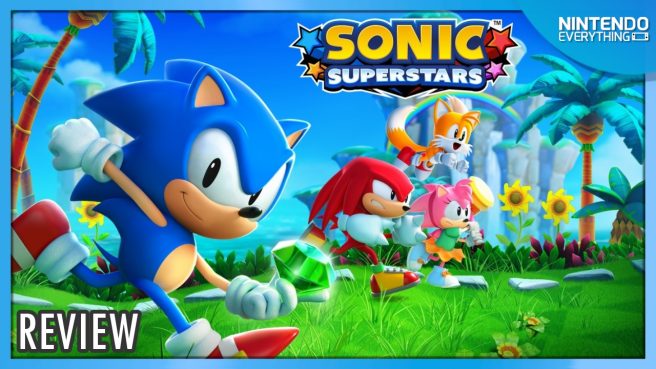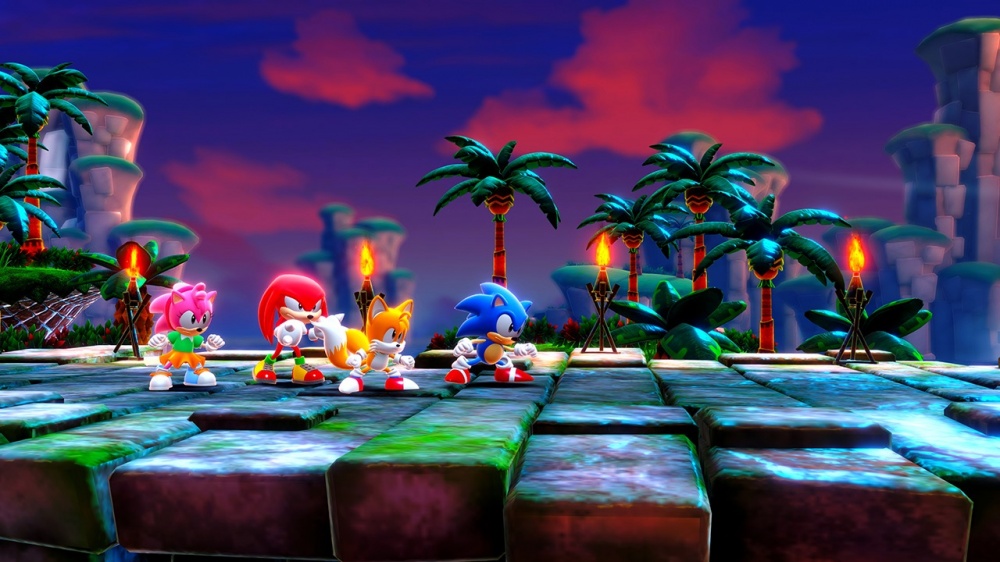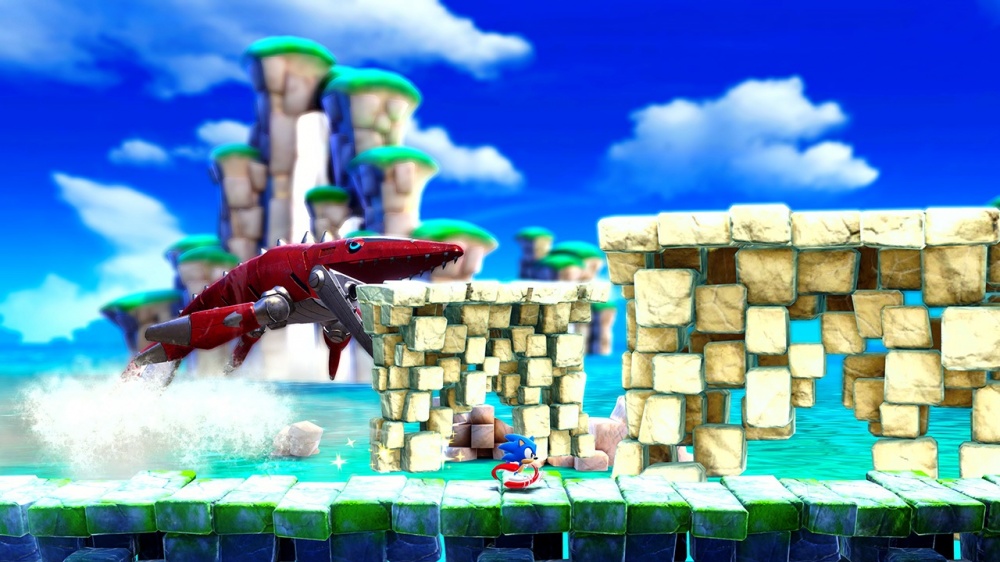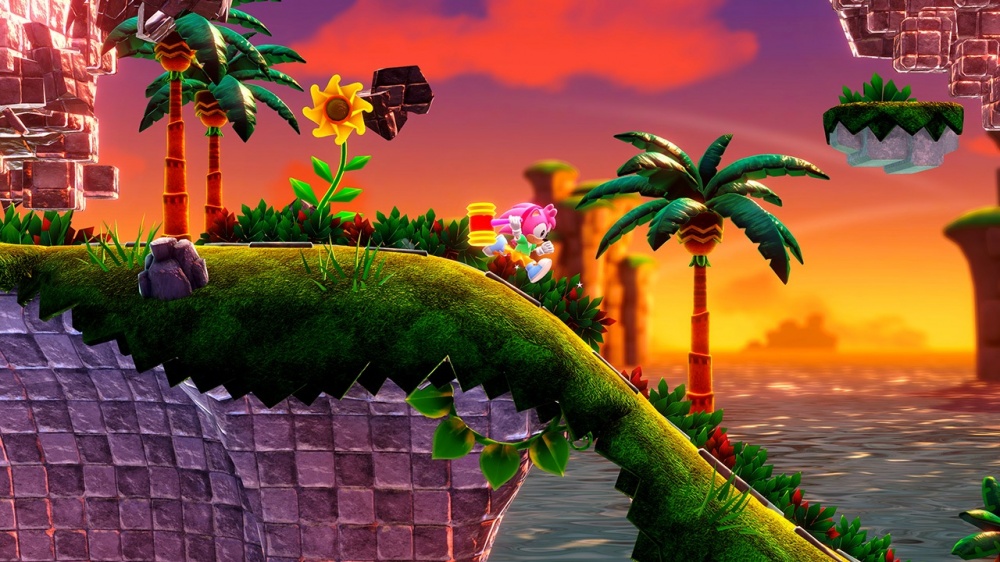System: Switch
Release date: October 17, 2023
Developer: Arzest / SEGA
Publisher: SEGA
Few video game mascots are as instantly recognizable as Sonic the Hedgehog, and even fewer have had such a turbulent career. It often feels as though SEGA doesn’t quite know what it wants to do with the character, and as a result it’s difficult to know what to expect from each new title. Sonic Superstars is now the latest outing for the blue blur, and although it hearkens back to the beloved 2D Genesis games that kickstarted the franchise, there are several modern elements thrown in to shake up the gameplay, both for better and for worse.
Sonic Superstars is light on story, and sticks to the tried-and-true premise of Dr. Eggman being up to his usual tricks, enlisting the help of Fang the Hunter (making his first significant return to the franchise since 1994, so for many he will be an unfamiliar face) and a new character, Trip the Sungazer. There are a few cutscenes sprinkled between each Zone to expand upon this, but these are designed more to remind you that these characters exist rather than to advance the plot in any significant fashion. There is slightly more plot to be uncovered once you have completed the main story, focusing on Trip, which gives her character a little more depth, and serves as a nice postgame challenge for those looking for more once they’ve finished the main story. I found that the absence of a more detailed narrative here felt more nostalgic than detrimental, although this may be something worth considering for fans of Sonic’s more recent 3D outings who are accustomed to more dialogue and exposition.
Sonic Superstars is a 2.5D side-scroller with gameplay inspired by the classic titles, where your objective is to navigate your way through a stage to reach the goal at the end. Despite the timer in the corner there is no actual time limit to speak of, and you can take as long as necessary to accomplish this: unless you’re familiar with the area, each Act will probably take anywhere between five and ten minutes to complete on your first run through. Unlike the classic titles Sonic Superstars does away with the lives system entirely, with the punishment for death being to simply deposit you back to the last checkpoint you activated – a much-needed anti-frustration feature – and the prize for gathering 100 rings is now a medal that can be used to purchase parts for an avatar character in the shop. You can also acquire medals from activating checkpoints when you have 50 rings (via bonus levels that are inspired by special stages from the original game, and are equally nauseating) with special stages being accessed via giant rings that are hidden in each area instead.
Sonic Superstars features eleven different Zones which are all entirely new to the series, but follow conventions that will make them instantly recognizable to longtime fans: the first, Bridge Island Zone, is your typical grassland area that is clearly meant to reference Green Hill Zone, for example. Most Zones are divided into two Acts, although there are additional Acts that can only be played with a specific character, and short extra Acts that see you trying to gather as many rings as possible. I was constantly impressed and delighted by the level design in the game, with each Act being a sprawling maze of twists and turns that always actively encouraged forward momentum and made it an enjoyable process, even during those times where the game required me to slow down to navigate a series of deceptively straightforward platforms to progress. Each one had unique means of traversal, with Cyber Station being a particular highlight for transforming your player character into different 3D pixelated forms at random intervals to progress. Although the gameplay is instantly familiar, Sonic Superstars does its best to innovate and introduce new means of progression with each new area.
There are numerous pathways through each area and this adds a lot of replayability to the game, as each of the game’s playable characters comes with their own set of skills that will allow you to access some places easier than others. After playing through the story mode for the first time exclusively as Sonic for a more classic-feeling experience, I found a second playthrough as Knuckles to be completely different as I uncovered new paths that I’d previously sped past without noticing, or been unable to reach. Unfortunately, there is very little reward for exploration, with special stages that allow you to acquire Chaos Emeralds being the highlight: these see you grappling from point to point to catch the Emerald within the time limit, and I found them to be somewhat frustrating at times, as it is difficult to control forward momentum and you can easily overshoot the target entirely.
Another major new feature introduced in Sonic Superstars are Emerald Powers, which you’ll unlock when acquiring Chaos Emeralds. I found the combat-based powers to be almost game-breakingly useful, with the Bullet and Slow powers in particular making bosses much easier to manage, allowing me to more effectively manage positioning and evade attacks. Conversely, those more tied to exploration, such as Vision and Ivy, were more situational and not things I tended to need to progress, making them feel like pointless additions by comparison. Emerald Powers need to be recharged at checkpoints before they can be used again, which prevents you from spamming them repeatedly and makes them feel more balanced, and overall they are a welcome additional incentive for gathering up the Chaos Emeralds, which in the past have only had a single reward (the Super transformation, which makes a return in this game too) for getting them all.
But despite its excellent level design, Sonic Superstars often feels like a game at odds with itself. The “gotta go fast” philosophy is often placed front and center, with long stretches of twisting tracks, springs, and loops being a recurring theme that will see the scenery melt into a blur and give an exhilarating and highly nostalgic rush. However, many of the later levels do not support this, and force you to take your time to navigate a series of obstacles that makes the game feel more like a 2D platformer than a traditional Sonic title, and the timing and level of precision required for jumps feels particularly harsh at times given the frailty of the characters: as always, being hit with no Rings results in death, and being hit with Rings will see you lose all of them and prompt a frantic rush to re-acquire as many as you can before your limited invulnerability wears off. Speeding through levels also carries with it the almost guaranteed certainty of missing out on Emerald Powers, which towards the end of the game begins to feel like a punishment for your earlier haste, necessitating replaying earlier levels at a much slower pace to uncover their secrets or face more difficult platforming segments and boss battles.
And those boss battles are generally not very enjoyable experiences at the best of times. All bosses follow a fixed pattern of attacks which should make them satisfying to overcome once you’ve figured them out, but I found most of them to be extremely tedious because of it. Bosses either have a very specific weak point that you need to hit or will be out of range for most of the fight outside of a brief moment where you’ll be able to strike back, and this makes the battle drag on for entirely too long when you need to hit them multiple times: it can take upwards of ten minutes just to defeat a boss, which can be double the amount of time you spent reaching them, and it disrupts the overall pacing of the game quite noticeably. You are also often hindered more by your environment rather than your ability to accurately predict and avoid a boss’ attacks when the time comes for you to take advantage of the opening they’ve given you: the Lagoon City boss stands out here, being an underwater fight and requiring you to use missiles and platforms to get into range for its final phase, all whilst managing your air supply.
Many bosses feel as though they were designed to be beaten with Emerald Powers, which can bypass a lot of the more difficult aspects of their attack patterns to allow you to get in a hit much sooner. If you have the required Emerald Power, bosses can become a simple and anticlimactic affair: using Lagoon City’s boss as an example again, the end phase becomes much easier if you can use the Bullet Power to just dash up to the boss to hit it, rather than needing to navigate the missiles and platforms first. But if you don’t have it then they can become an unnecessary roadblock to progression, forcing you to either try repeatedly and hope that you’re lucky enough that your environment will let you hit the boss when the time is right, or go back through the stages and try to find the ring so you can get the Emerald Power you need. Assuming, of course, that you can clear the special stage.
It is in my opinion a definite step down from classic Sonic titles, in which you only needed to avoid attacks while you moved towards a boss, or could hit them multiple times between attacks, and bosses in Sonic Superstars feel more like they were designed for a game where you can take more than two hits before dying, or have ways to recover health mid-fight that don’t involve frantically scrambling for dropped rings before they disappear. In longer fights, the lack of checkpoints between phases can also be particularly debilitating, as failure will require you to push through the first phase again. What should be a triumphant capstone to blazing through a level becomes a punishment for having done so, and there are times when it can sour the experience.
From a visual standpoint Sonic Superstars looks absolutely fantastic on the Switch, with the Switch OLED screen in particular more than making up for the lack of sharpness and lower resolution when compared to versions on other systems. But even on a regular system or a TV screen the game is a visual treat: graphics are bright and colorful, clearly drawing from the series’ 2D style but adding a level of polish and detail that give the game a more modern aesthetic.
Performance matches the visuals, with stable frame rates throughout, although there is some very noticeable stuttering during loading screens. Thankfully, this does not translate into actual gameplay: the worst I experienced was some awkward pausing in the loading screen animation, and one particularly long and jarring loading screen before Act 2 of the final area – the reason for this longer than average pause became abundantly clear once the act had loaded, however. Apart from this one anomaly, once the game has loaded that next area (which it does with a reasonable degree of speed) everything runs smoothly and is quite a pleasant experience on Switch.
The Verdict

Sonic Superstars is an enjoyable game and will go a long way towards satisfying fans looking for a classic 2D Sonic experience, but elements of its gameplay design are at odds with this and often make it feel more like a more modern 3D Sonic title, and this doesn’t always work out in its favor. The game is at its best when allowing you to speed through levels, but unfortunately it often requires you to slow down. There is a heavy emphasis on exploration and replayability, and this gives value to playing as every character, but it often feels mandatory, particularly when facing bosses which are unreasonably difficult and clearly designed to be beaten after you’ve acquired a particular Emerald Power. But despite these moments of frustration I would argue that this is one of Sonic’s better outings in recent years, and an easy recommendation for fans who have been dissatisfied with more recent titles, and for anyone interested in experiencing classic Sonic gameplay with some modern concessions.
Sonic Superstars copy provided by the publisher for the purposes of this review.




